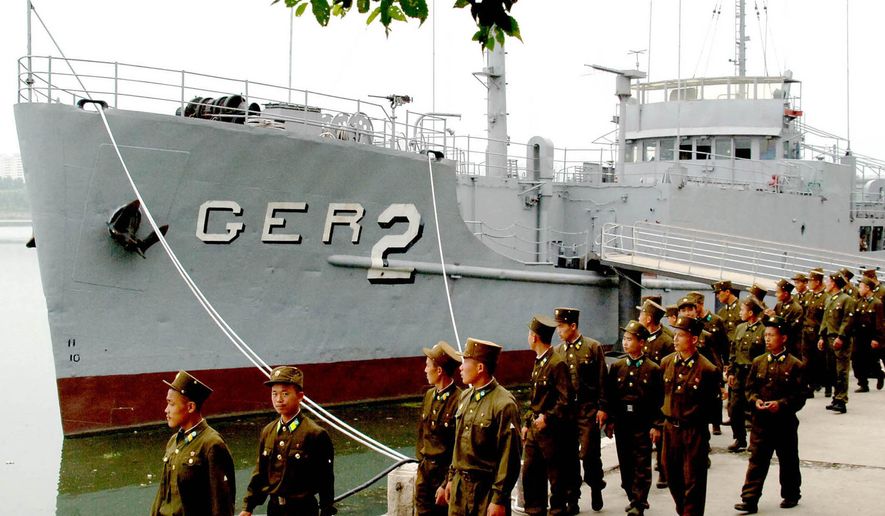The USS Constitution, the oldest commissioned ship in the Navy, sits in Boston, revered by sailors and history buffs.
The second-oldest ship, the USS Pueblo, floats at a river dock in Pyongyang, still a hostage more than 50 years after North Korea seized it in a January 1968 raid in the frigid waters of the East Sea off the hermit kingdom’s northeastern coast.
Calls from the surviving crew to bring the ship back have amounted to naught. The Colorado legislature, protective of the ship named after one of its cities, also weighs in every year with a resolution calling for the ship’s return.
After one version passed 10 years ago, a state lawmaker received a postcard featuring a photo of a North Korean soldier smashing his rifle butt against the head of a Western-looking man in a blue uniform. The card had a North Korean postmark and a message. In flawless English, the writer urged the politician to “come and take it, you dirty American.”
That’s the polite version of what was written, said state Sen. Bob Gardner, a Republican from Colorado Springs and one of the sponsors of the “bring home the Pueblo” resolution this year. Mr. Gardner still marvels at the perfect, idiomatic English written on the unsigned card.
“But it proved that someone in Korea was watching our resolution even if no one in America does,” Mr. Gardner said.
As President Trump meets with North Korean leader Kim Jong-un in Singapore, the possession of the USS Pueblo remains a sticking point between the two nations.
The Pentagon declined to comment on any efforts for the return of the Pueblo and referred all questions to the White House. The White House did not respond.
Yet it wouldn’t be completely out of left field for Mr. Trump to mention the Navy ship, given the anniversary of its seizing in what the U.S. insists was open ocean but North Korea says were its own territorial waters.
“This year marks the 50th anniversary of North Korea’s seizure of the USS Pueblo and I, like many others in our state, want to see the ship returned home,” Rep. Scott R. Tipton, Colorado Republican, wrote to President Trump last month. “The historic summit that is to be held … presents a rare opportunity to directly make this request.”
The Pueblo was a spy ship assigned to monitor North Korean communications. It was laden with top-secret intelligence reports and machinery.
The North Koreans detected the Pueblo and sent a flotilla to surround it, assisted by MiG fighters overhead. They demanded surrender and sent a boarding party, which raked the bridge and decks with gunfire. The captain and several others were wounded, and one crew member, Duane Hodges, was killed.
Capt. Lloyd Bucher ordered his crew to smash the intelligence equipment and burn or shred the documents. There was so much that they even began to dump documents overboard, according to the USS Pueblo Veterans Association.
The U.S. insists the Pueblo was in international waters, and North Korea says it was inside the country’s boundaries. North Koreans seized the ship and crew, who were held and tortured for 335 days.
The Cold War crisis was finally resolved in vintage Hollywood fashion two days before Christmas 1968 when the gaunt prisoners walked, one by one, across the Bridge of No Return in the Demilitarized Zone separating North and South Korea.
The prisoners were released after the U.S. signed an apology of sorts — then quickly rescinded it once all the American personnel were safely returned.
A National Security Agency analysis, declassified in 2012, described the scope of the intelligence disaster, saying North Korea was able to figure out which codes the U.S. had broken, which telecommunications systems the U.S. was able to monitor and who in the North Korean hierarchy was of interest to the U.S.
The Pueblo’s capture was such a coup that North Korea turned the ship into a tourist attraction in Pyongyang. It is floating in a berth along the Potong River and it is replete with the kind of totalitarian English that the postcard writer eschewed.
“The myth of the mightiness of the U.S. was shattered again by the heroic Korean people,” reads some of the propaganda, which also calls the Pueblo “a witness of history and trophy” of the “century after century the crimes of aggression committed by the U.S. imperialists against the Korean people.”
Attempts by The Washington Times to reach two surviving crew members were unsuccessful.
But some of the crew, as well as families and estates of others, filed a lawsuit against North Korea this year under a U.S. law that allows victims to demand compensation from foreign governments for terrorism or hostage-taking.
Whatever the history, Mr. Gardner said, the time is right to ask for the ship’s return.
“It’s somewhat symbolic, but it is an important piece of any agreement that might be reached,” he said. “It’s important, and it is on our minds this week with the summit. It’s still on the Navy rolls, and it remains important to us because there’s an emotional attachment to that.”
• James Varney can be reached at jvarney@washingtontimes.com.




Please read our comment policy before commenting.